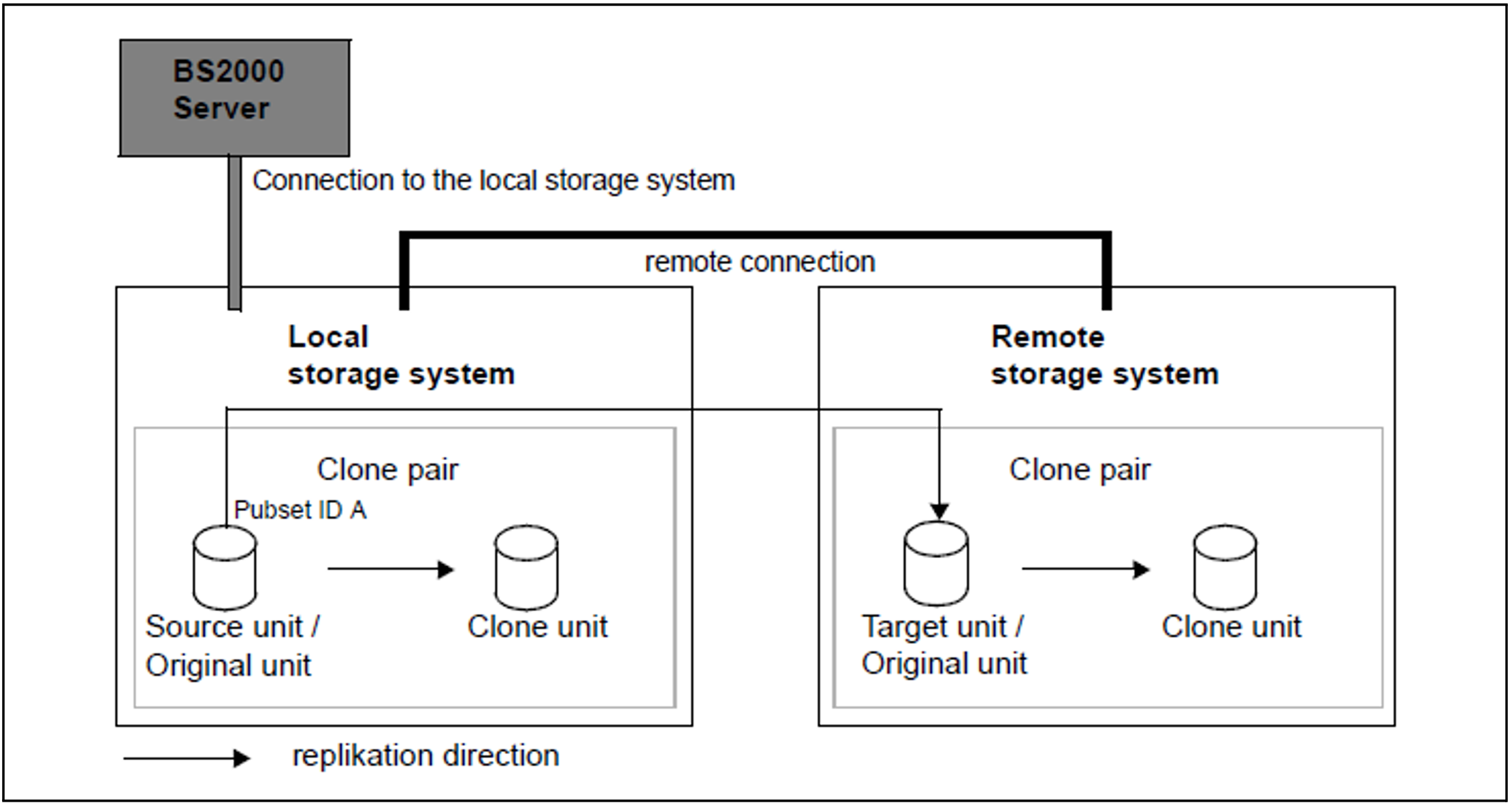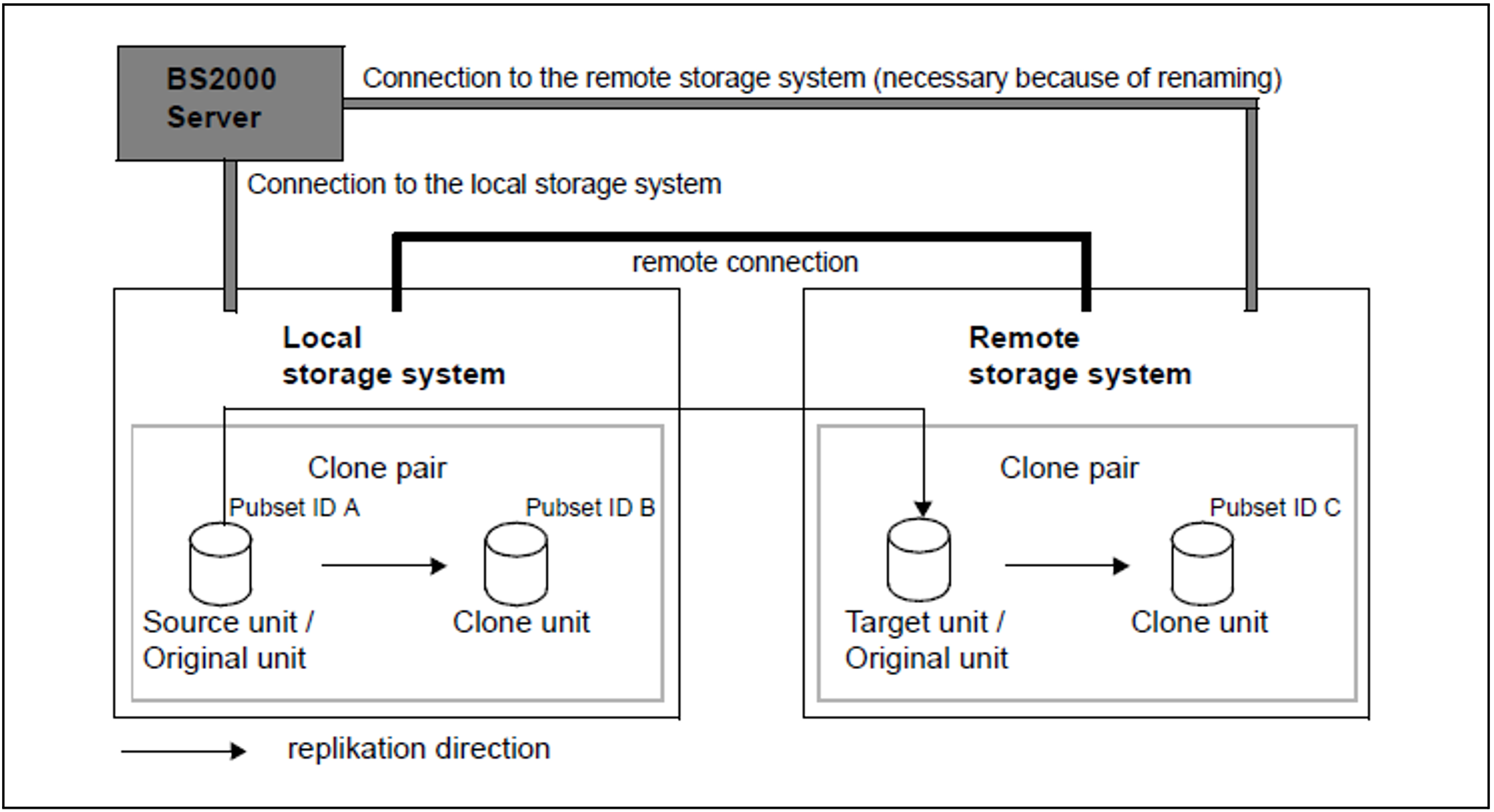This configuration defines a cascade of local and remote replication.
A clone pair can consist of a unit which is simultaneously the REC target unit and a clone unit. In this case the clone pair generally cannot be accessed via the VSN or the pubset ID because the target unit is not readable. If the source unit is attached, the pubset ID of the source unit can be specified in the clone session commands using the UNIT=*BY-PUBSET(...) operand in conjunction with SELECT=*TARGET-UNIT.
The following requirements must be met to permit a clone pair with a target unit to be selected via the VSN or pubset ID:
The source unit is attached.
For
/ACTIVATE-CLONE(only for EC) or/START-CLONE-SESSIONand/RESTART-CLONE-SESSION(for QuickOPC only) one of the following two cases applies:Remote copy mode is interrupted;
/SHOW-REMOTE-COPY-STATUSdisplays the remote copy statusIN-HOLDorERROR.In the case of remote copy mode, synchronous processing mode is set and the remote copy pair is synchronized.
If BS2000 is connected to the remote storage system via Fibre Channel, SF pubsets can be implicitly renamed with the RESTORE-FROM-CLONE, RESTART-CLONE-SESSION (QuickOPC only), START-CLONE-SESSION (QuickOPC only) and ACTIVATE-CLONE (EC only) commands and the NEW-PUBSET=<new cat-id> operand. The I/Os to the source unit can be suspended in ongoing operation by means of the HOLD-IO=*UNTIL-ACTIVATED operand to ensure consistent splitting.
Scenarios for QuickOPC/EC in REC configurations
Without renaming of the clone units
The source unit and target unit form a remote copy pair (see the figure below).
At the same time the two also form a clone pair:
The source unit with the clone unit of the local storage system
The target unit with the clone unit of the remote storage system
Figure 27: QuickOPC/EC Clone with REC, no renaming of the clone units
The server has no connections to the remote storage system, which cannot therefore be accessed directly from the server. The target unit cannot be addressed via the VSN or pubset ID. The source unit has pubset ID A.
For QuickOPC:
The clone unit in the remote storage system is updated with /RESTART-CLONE-SESSION UNIT=*BY-PUBSET(PUBSET=A),SELECT=*TARGET-UNIT.
For EC:
The clone unit in the remote storage system is activated with /ACTIVATE-CLONE UNIT=*BY-PUBSET(PUBSET=A),SELECT=*TARGET-UNIT.
With renaming of the clone units
The source unit and target unit form a remote copy pair (see the figure below).
At the same time each of the two units forms a clone pair:
The source unit with the clone unit of the local storage system
The target unit with the clone unit of the remote storage system
Figure 28: QuickOPC/EC Clone with REC with renaming of the clone unit in the remote storage system
The server has connections to the remote storage system, which means that it can be accessed directly by the server. The target unit cannot be addressed via the VSN or pubset ID. The source unit has pubset ID A.
For QuickOPC:
/RESTART-CLONE-SESSION UNIT=*BY-PUBSET(PUBSET=A,NEW-PUBSET=B) causes the clone unit in the local storage system to be updated. The pubset ID of the clone unit is changed to B.
/RESTART-CLONE-SESSION UNIT=*BY-PUBSET(PUBSET=A,NEW-PUBSET=C), SELECT=*TARGET-UNIT is used to update the clone unit in the remote storage system. The pubset ID of the clone unit is changed to C.
For EC:
/ACTIVATE-CLONE UNIT=*BY-PUBSET(PUBSET=A,NEW-PUBSET=B) is used to activate the clone pair in the local storage system. The pubset ID of the clone unit is changed to B.
/ACTIVATE-CLONE UNIT=*BY-PUBSET(PUBSET=A,NEW-PUBSET=C),SELECT=*TARGET-UNIT is used to split the clone pair in the remote storage system, and the pubset ID of the clone unit is changed to C.
This permits the units to be used as follows, for example:
the source unit (with pubset ID A) for the main application
The clone unit of the local storage system (with pubset ID B) for the backup
the target unit as a copy in case a disaster occurs
The clone unit of the remote storage system (with pubset ID C) for evaluations


